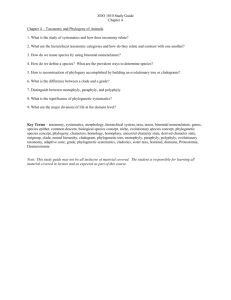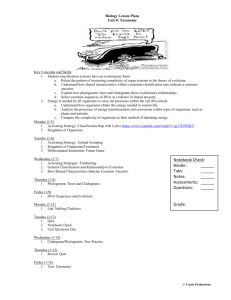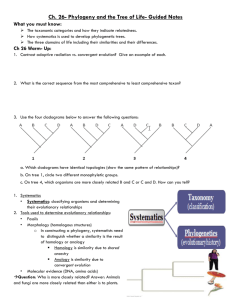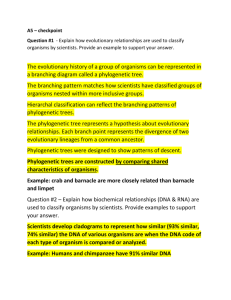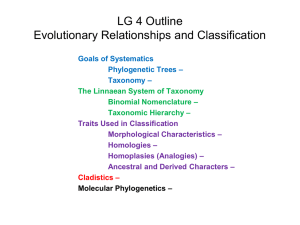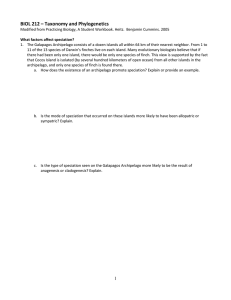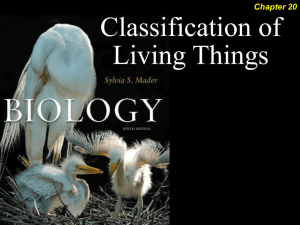PPt for Ch 26 - Phillips Scientific Methods
advertisement
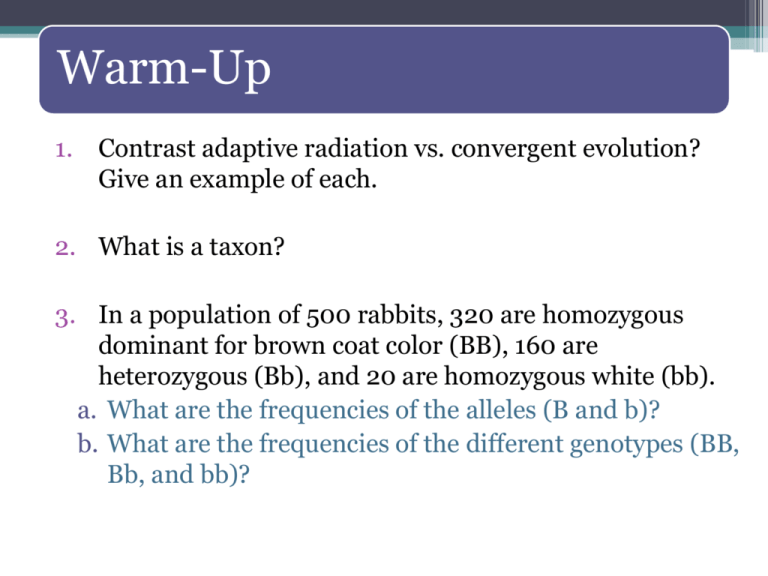
Warm-Up 1. Contrast adaptive radiation vs. convergent evolution? Give an example of each. 2. What is a taxon? 3. In a population of 500 rabbits, 320 are homozygous dominant for brown coat color (BB), 160 are heterozygous (Bb), and 20 are homozygous white (bb). a. What are the frequencies of the alleles (B and b)? b. What are the frequencies of the different genotypes (BB, Bb, and bb)? Chapter 26 Ch 26: Phylogeny and the Tree of Life What you need to know: • The taxonomic categories and how they indicate relatedness. • How systematics is used to develop phylogenetic trees. • The three domains of life including their similarities and their differences. Systematics: classifying organisms and determining their evolutionary relationships Taxonomy (classification) Systematics Phylogenetics (evolutionary history) Tools used to determine evolutionary relationships: 1. Fossils 2. Morphology (homologous structures) 3. Molecular evidence (DNA, amino acids) Who is more closely related? Animals and fungi are more closely related than either is to plants. Taxonomy: science of classifying and naming organisms • Binomial nomenclature (Genus species) Naming system developed by Carolus Linnaeus. REMEMBER!! • Dear King Philip Came Over For Good Spaghetti • Dear King Philip Crossed Over Five Great Seas • Dumb King Philip Came Over From Germany Sailing • Your own??? Phylogenetic Tree • Branching diagram that shows evolutionary history of a group of organisms Activity: Constructing a Cookie Phylogenetic Tree Activity: Constructing a Cookie Phylogenetic Tree Living (extant) species Common ancestor (fossil) Extant species Common ancestor Example of a Cookie Tree Cladogram: diagram that depicts patterns of shared characteristics among taxa • Clade = group of species that includes an ancestral species + all descendents • Shared derived characteristics are used to construct cladograms Turtle Leopard Hair Salamander Amniotic egg Tuna Four walking legs Lamprey Lancelet (outgroup) Cladogram Hinged jaws Vertebral column Monophyletic, paraphyletic, and polyphyletic groups Need help? See next slide Need more help understanding phylogenetic trees/cladograms? • Take a visit to the ‘Tree Room’! http://evolution.berkeley.edu/evolibrary/article /0_0_0/evotrees_intro Constructing a phylogenetic tree A 0 indicates a character is absent; a 1 indicates that a character is present. Branch lengths can represent genetic change Branch lengths can indicate time Draw a phylogenetic tree based on the data below. Draw hatch marks on the tree to indicate the origin(s) of each of the 6 characters. Answer: Various tree layouts Circular (rooted) tree Unrooted tree Rooted tree • Principle of maximum parsimony: use simplest explanation (fewest DNA changes) for tree – “keep it simple” • Molecular clocks: some regions of DNA appear to evolve at constant rates ▫ Estimate date of past evolutionary events ▫ Ex. Origin of HIV infection in humans= 1930’s ▫ What is a major problem with a molecular clock? Tree of Life • 3 Domains: Bacteria, Archaea, Eukarya • Tool for Classification: Dichotomous Key http://www.biologycorner.com/worksheets/pamishan.html Definition: • Dichotomous Key: uses contrasting characteristics to determine the identity of an organism by dividing the organisms in the key into smaller and smaller groups; each time a choice is made, a number of organisms are eliminated. If sufficient characteristics are contrasted, the number of possibilities for the identity of the unknown organism is eventually reduced to one. Example SYSTEMATICS phylogeny Biological diversity taxonomy cladistics classification Identification of species binomial Genus, species D K P C O F G S Homologous similarities fossils molecular morphology



